

Compact Muon Solenoid
LHC, CERN
| CMS-PAS-B2G-22-006 | ||
| Search for new particles decaying into top quark-antiquark pairs in events with one lepton and jets in proton-proton collisions at 13 TeV | ||
| CMS Collaboration | ||
| 3 April 2025 | ||
| Abstract: A search for new particles decaying to top quark-antiquark pairs is performed using proton-proton collisions at a centre-of-mass energy of 13 TeV. The data recorded with the CMS detector between 2016 and 2018 are used, corresponding to an integrated luminosity of 138 fb$ ^{-1} $. Events containing exactly one muon or one electron, at least two jets, and missing transverse momentum in the final state are considered. Different models of new physics are probed. No significant deviation from the prediction is observed and upper limits are set on the production cross section for heavy resonances. A Z' boson with 1%, 10%, and 30% relative width is excluded for masses in the range 0.4-4.3, 0.4-5.3, and 0.4-6.7 TeV, respectively. A Kaluza-Klein gluon in the Randall-Sundrum model and a dark matter mediator are excluded for masses between 0.5-4.7 TeV and 1.0-3.2 TeV, respectively. Moreover, upper limits are set on the coupling strength modifier for scalar and pseudoscalar Higgs bosons in the two-Higgs-doublet models for 2.5%, 10%, and 25% relative widths in the mass range 0.5-1 TeV. | ||
| Links: CDS record (PDF) ; CADI line (restricted) ; | ||
| Figures | |

png pdf |
Figure 1:
Example Feynman diagrams at leading order for the production and decay of a Z'/$ \mathrm{ g_{KK} } $ (left) and a scalar H or pseudoscalar A resonance (right). |
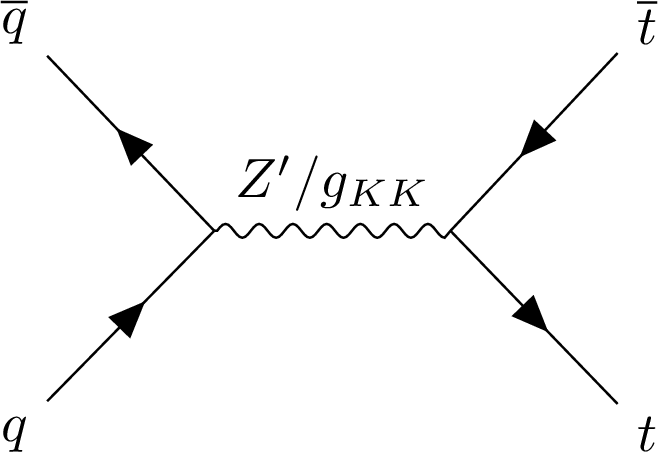
png pdf |
Figure 1-a:
Example Feynman diagrams at leading order for the production and decay of a Z'/$ \mathrm{ g_{KK} } $ (left) and a scalar H or pseudoscalar A resonance (right). |
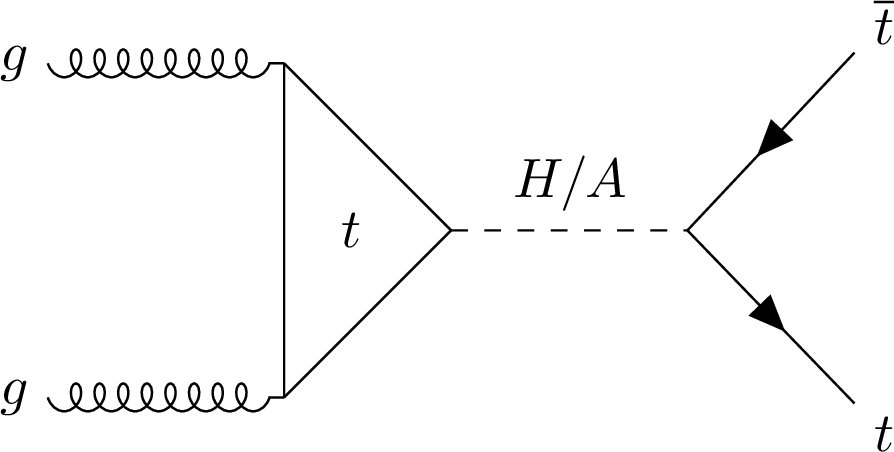
png pdf |
Figure 1-b:
Example Feynman diagrams at leading order for the production and decay of a Z'/$ \mathrm{ g_{KK} } $ (left) and a scalar H or pseudoscalar A resonance (right). |

png pdf |
Figure 2:
Reconstructed invariant mass distribution for Z' bosons for different mass hypotheses. Each distribution corresponds to a production cross section of 1\unitpb. |
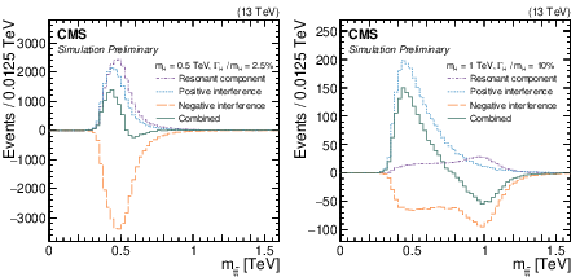
png pdf |
Figure 3:
Different contributions to the $ m_{{\mathrm{t}\overline{\mathrm{t}}} } $ distribution for scalar Higgs bosons with masses of 0.5 TeV (left) and 1 TeV (right), and corresponding total widths of 2.5% and 10%, respectively. Each distribution is normalized to the corresponding production cross section. |
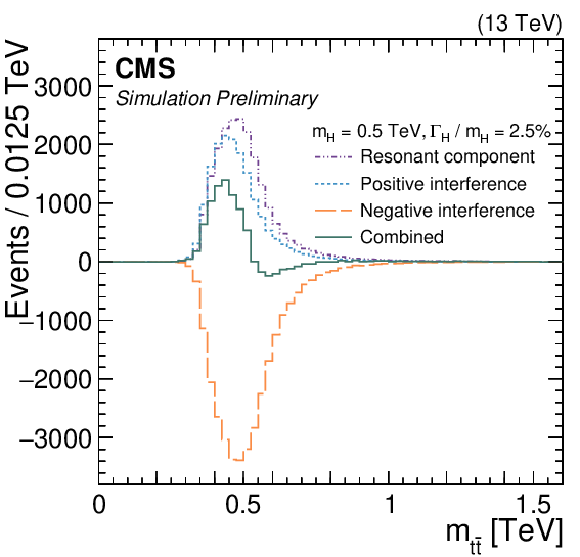
png pdf |
Figure 3-a:
Different contributions to the $ m_{{\mathrm{t}\overline{\mathrm{t}}} } $ distribution for scalar Higgs bosons with masses of 0.5 TeV (left) and 1 TeV (right), and corresponding total widths of 2.5% and 10%, respectively. Each distribution is normalized to the corresponding production cross section. |
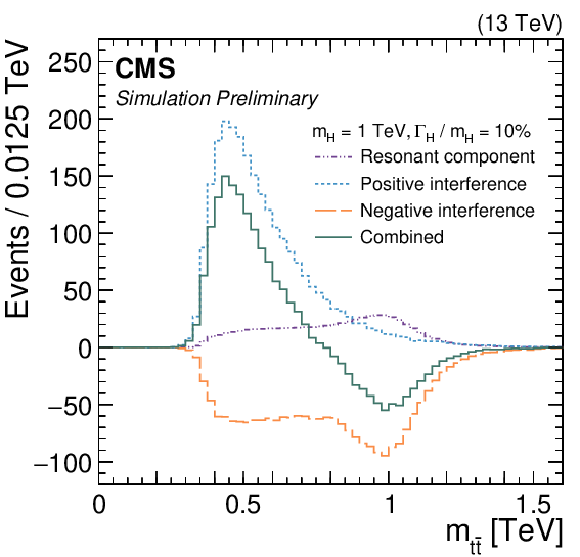
png pdf |
Figure 3-b:
Different contributions to the $ m_{{\mathrm{t}\overline{\mathrm{t}}} } $ distribution for scalar Higgs bosons with masses of 0.5 TeV (left) and 1 TeV (right), and corresponding total widths of 2.5% and 10%, respectively. Each distribution is normalized to the corresponding production cross section. |
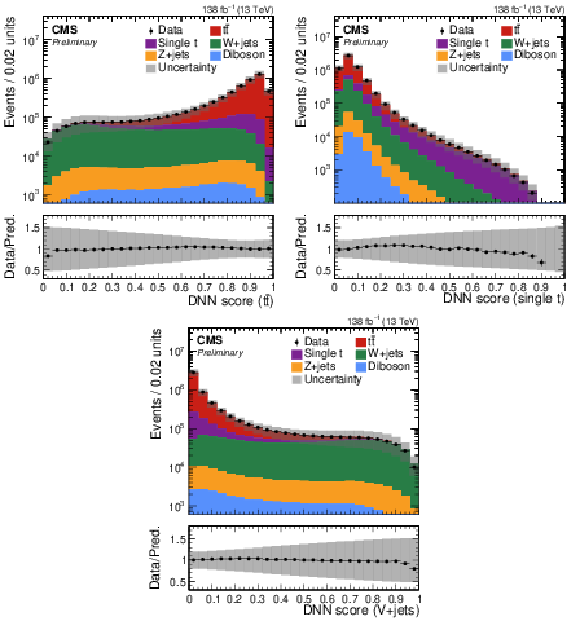
png pdf |
Figure 4:
DNN score distributions for the combined electron and muon channels: $ \mathrm{t} \overline{\mathrm{t}} $ score (top left), single t score (top right), and V+jets} score (lower). The lower panels show the ratio of the data to the total SM background prediction. The gray bands represent the uncertainty, computed by summing in quadrature the statistical uncertainty and the systematic uncertainties affecting the normalization of each process. |
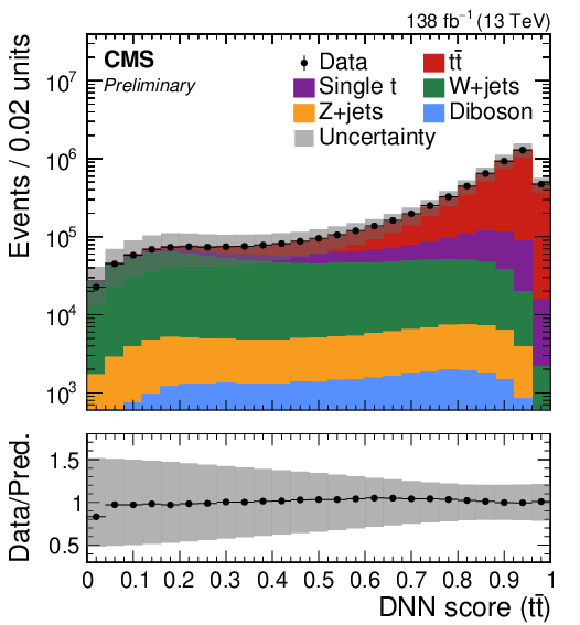
png pdf |
Figure 4-a:
DNN score distributions for the combined electron and muon channels: $ \mathrm{t} \overline{\mathrm{t}} $ score (top left), single t score (top right), and V+jets} score (lower). The lower panels show the ratio of the data to the total SM background prediction. The gray bands represent the uncertainty, computed by summing in quadrature the statistical uncertainty and the systematic uncertainties affecting the normalization of each process. |
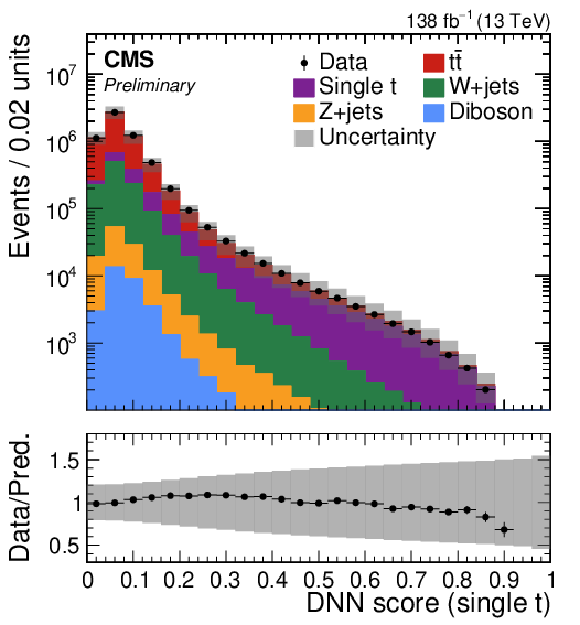
png pdf |
Figure 4-b:
DNN score distributions for the combined electron and muon channels: $ \mathrm{t} \overline{\mathrm{t}} $ score (top left), single t score (top right), and V+jets} score (lower). The lower panels show the ratio of the data to the total SM background prediction. The gray bands represent the uncertainty, computed by summing in quadrature the statistical uncertainty and the systematic uncertainties affecting the normalization of each process. |
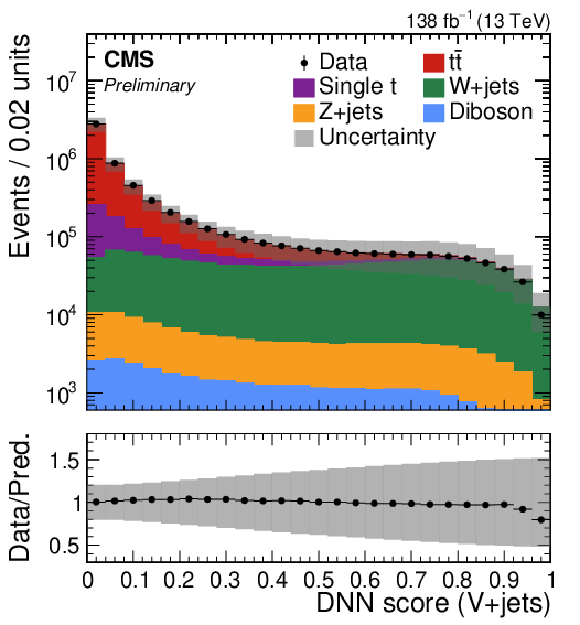
png pdf |
Figure 4-c:
DNN score distributions for the combined electron and muon channels: $ \mathrm{t} \overline{\mathrm{t}} $ score (top left), single t score (top right), and V+jets} score (lower). The lower panels show the ratio of the data to the total SM background prediction. The gray bands represent the uncertainty, computed by summing in quadrature the statistical uncertainty and the systematic uncertainties affecting the normalization of each process. |
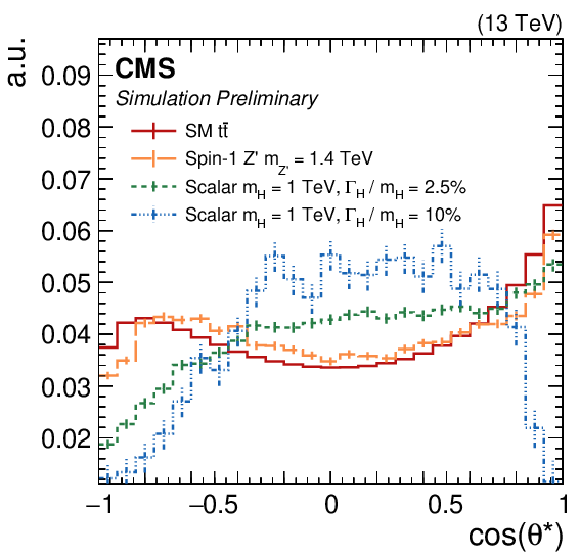
png pdf |
Figure 5:
Distribution of $ \cos(\theta^*) $ for different processes: SM $ \mathrm{t} \overline{\mathrm{t}} $ (solid red), Z' with $ m_{{\mathrm{t}\overline{\mathrm{t}}} }= $ 1.4 TeV (long-dashed orange), scalar H with $ m_{\mathrm{H}}= $ 1 TeV and 2.5% relative width (short-dashed green), and scalar H with $ m_{\mathrm{H}}= $ 1 TeV and 10% relative width (dash-dotted blue). The fluctuations observed in the scalar signal samples, particularly for larger relative widths, arise from the interplay between the resonant and interference components. All distributions are normalized to unit area. |
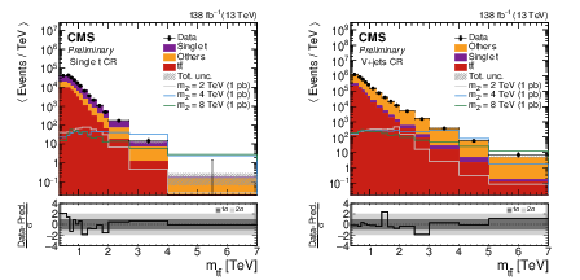
png pdf |
Figure 6:
Postfit distributions in $ m_{{\mathrm{t}\overline{\mathrm{t}}} } $ for data and simulation in the single t (left) and V+jets} (right) CRs. The lower panels show the pull of each bin relative to the SM prediction, defined as (Data-Pred.)/$ \sigma $, where $ \sigma $ denotes the total uncertainty. The dark (light) gray band represents a pull of one (two) standard deviations from the predicted value. |
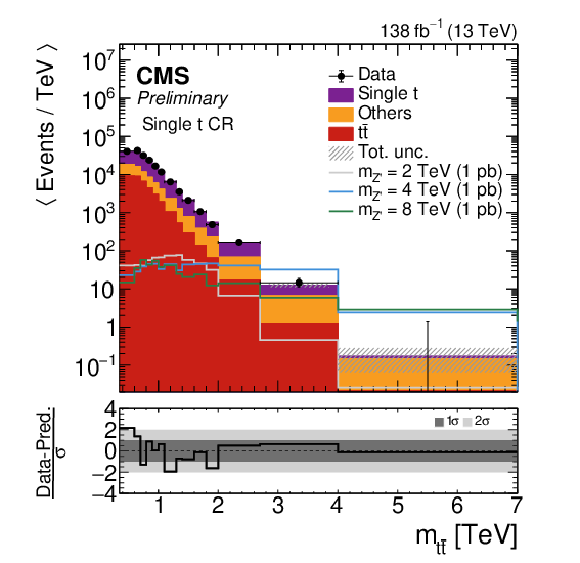
png pdf |
Figure 6-a:
Postfit distributions in $ m_{{\mathrm{t}\overline{\mathrm{t}}} } $ for data and simulation in the single t (left) and V+jets} (right) CRs. The lower panels show the pull of each bin relative to the SM prediction, defined as (Data-Pred.)/$ \sigma $, where $ \sigma $ denotes the total uncertainty. The dark (light) gray band represents a pull of one (two) standard deviations from the predicted value. |
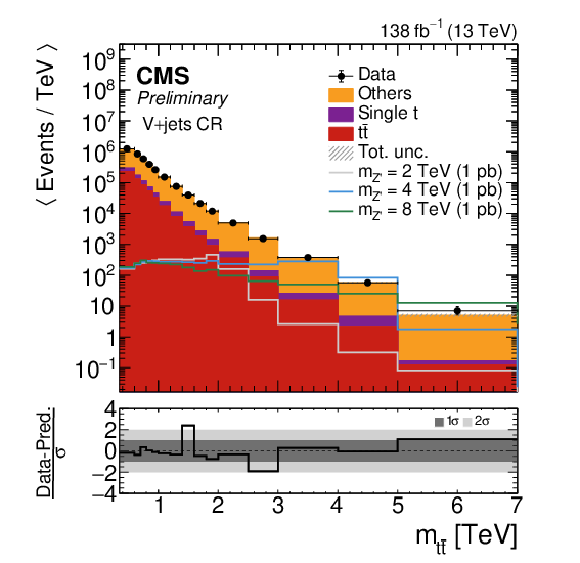
png pdf |
Figure 6-b:
Postfit distributions in $ m_{{\mathrm{t}\overline{\mathrm{t}}} } $ for data and simulation in the single t (left) and V+jets} (right) CRs. The lower panels show the pull of each bin relative to the SM prediction, defined as (Data-Pred.)/$ \sigma $, where $ \sigma $ denotes the total uncertainty. The dark (light) gray band represents a pull of one (two) standard deviations from the predicted value. |
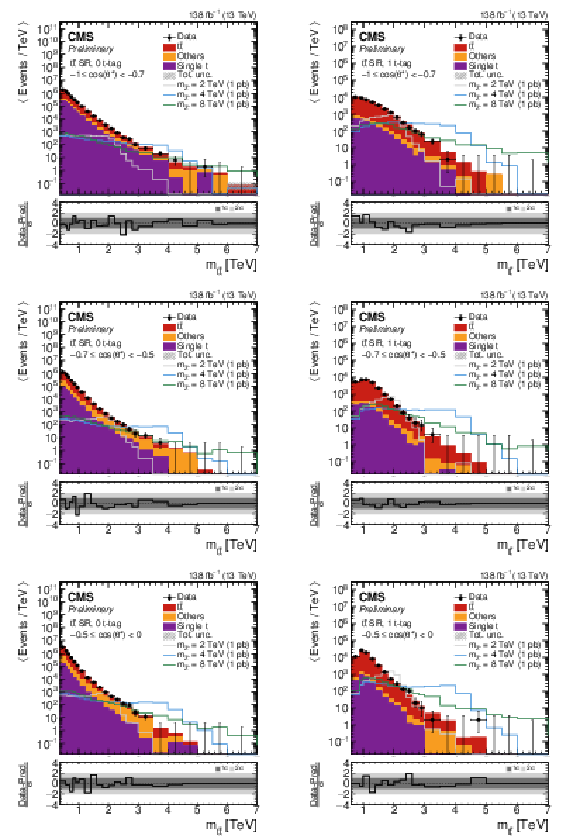
png pdf |
Figure 7:
Postfit distributions in $ m_{{\mathrm{t}\overline{\mathrm{t}}} } $ for data and simulation in the first three bins of $ \cos(\theta^*) $ in the $ \mathrm{t} \overline{\mathrm{t}} $ SR, shown for the resolved (0 t-tag, left) and boosted (1 t-tag, right) categories. The lower panels show the pull of each bin relative to the SM prediction, defined as (Data-Pred.)/$ \sigma $, where $ \sigma $ denotes the total uncertainty. The dark (light) gray band represents a pull of one (two) standard deviations from the predicted value. |

png pdf |
Figure 7-a:
Postfit distributions in $ m_{{\mathrm{t}\overline{\mathrm{t}}} } $ for data and simulation in the first three bins of $ \cos(\theta^*) $ in the $ \mathrm{t} \overline{\mathrm{t}} $ SR, shown for the resolved (0 t-tag, left) and boosted (1 t-tag, right) categories. The lower panels show the pull of each bin relative to the SM prediction, defined as (Data-Pred.)/$ \sigma $, where $ \sigma $ denotes the total uncertainty. The dark (light) gray band represents a pull of one (two) standard deviations from the predicted value. |
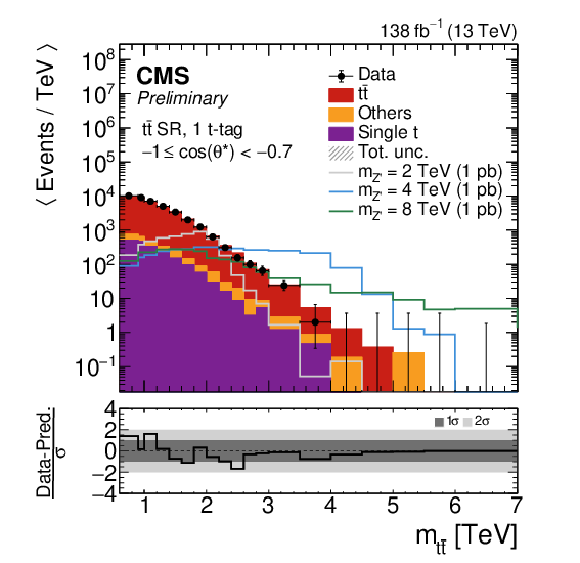
png pdf |
Figure 7-b:
Postfit distributions in $ m_{{\mathrm{t}\overline{\mathrm{t}}} } $ for data and simulation in the first three bins of $ \cos(\theta^*) $ in the $ \mathrm{t} \overline{\mathrm{t}} $ SR, shown for the resolved (0 t-tag, left) and boosted (1 t-tag, right) categories. The lower panels show the pull of each bin relative to the SM prediction, defined as (Data-Pred.)/$ \sigma $, where $ \sigma $ denotes the total uncertainty. The dark (light) gray band represents a pull of one (two) standard deviations from the predicted value. |
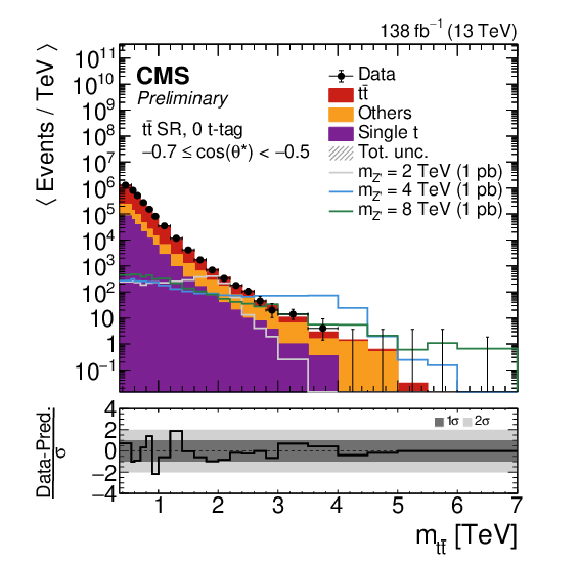
png pdf |
Figure 7-c:
Postfit distributions in $ m_{{\mathrm{t}\overline{\mathrm{t}}} } $ for data and simulation in the first three bins of $ \cos(\theta^*) $ in the $ \mathrm{t} \overline{\mathrm{t}} $ SR, shown for the resolved (0 t-tag, left) and boosted (1 t-tag, right) categories. The lower panels show the pull of each bin relative to the SM prediction, defined as (Data-Pred.)/$ \sigma $, where $ \sigma $ denotes the total uncertainty. The dark (light) gray band represents a pull of one (two) standard deviations from the predicted value. |
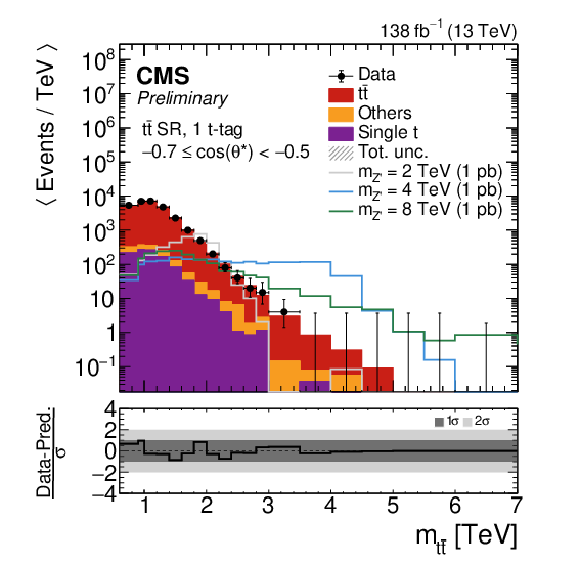
png pdf |
Figure 7-d:
Postfit distributions in $ m_{{\mathrm{t}\overline{\mathrm{t}}} } $ for data and simulation in the first three bins of $ \cos(\theta^*) $ in the $ \mathrm{t} \overline{\mathrm{t}} $ SR, shown for the resolved (0 t-tag, left) and boosted (1 t-tag, right) categories. The lower panels show the pull of each bin relative to the SM prediction, defined as (Data-Pred.)/$ \sigma $, where $ \sigma $ denotes the total uncertainty. The dark (light) gray band represents a pull of one (two) standard deviations from the predicted value. |
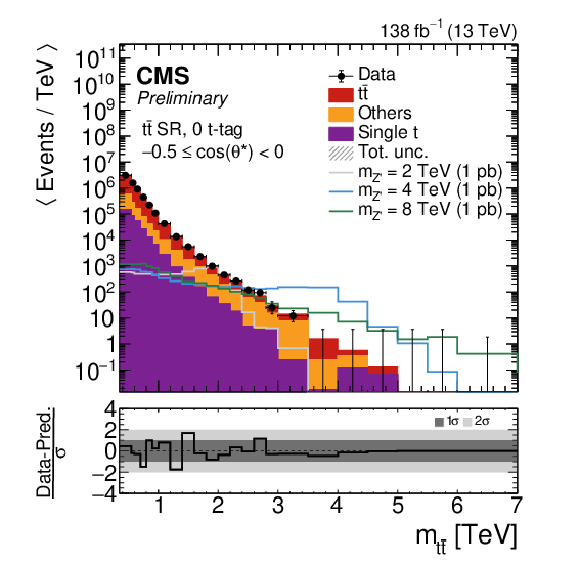
png pdf |
Figure 7-e:
Postfit distributions in $ m_{{\mathrm{t}\overline{\mathrm{t}}} } $ for data and simulation in the first three bins of $ \cos(\theta^*) $ in the $ \mathrm{t} \overline{\mathrm{t}} $ SR, shown for the resolved (0 t-tag, left) and boosted (1 t-tag, right) categories. The lower panels show the pull of each bin relative to the SM prediction, defined as (Data-Pred.)/$ \sigma $, where $ \sigma $ denotes the total uncertainty. The dark (light) gray band represents a pull of one (two) standard deviations from the predicted value. |
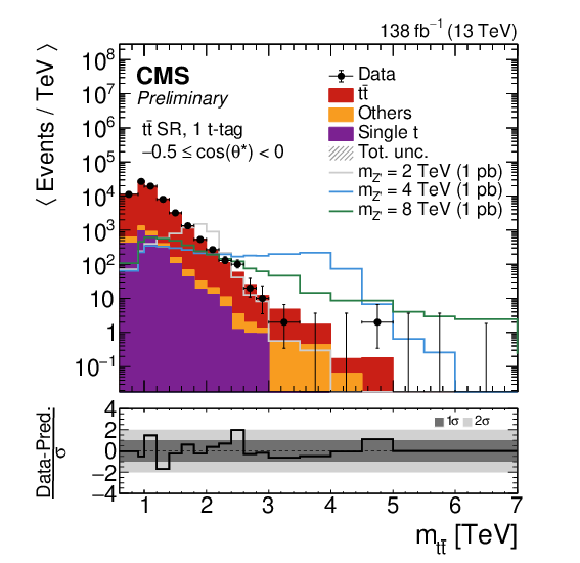
png pdf |
Figure 7-f:
Postfit distributions in $ m_{{\mathrm{t}\overline{\mathrm{t}}} } $ for data and simulation in the first three bins of $ \cos(\theta^*) $ in the $ \mathrm{t} \overline{\mathrm{t}} $ SR, shown for the resolved (0 t-tag, left) and boosted (1 t-tag, right) categories. The lower panels show the pull of each bin relative to the SM prediction, defined as (Data-Pred.)/$ \sigma $, where $ \sigma $ denotes the total uncertainty. The dark (light) gray band represents a pull of one (two) standard deviations from the predicted value. |
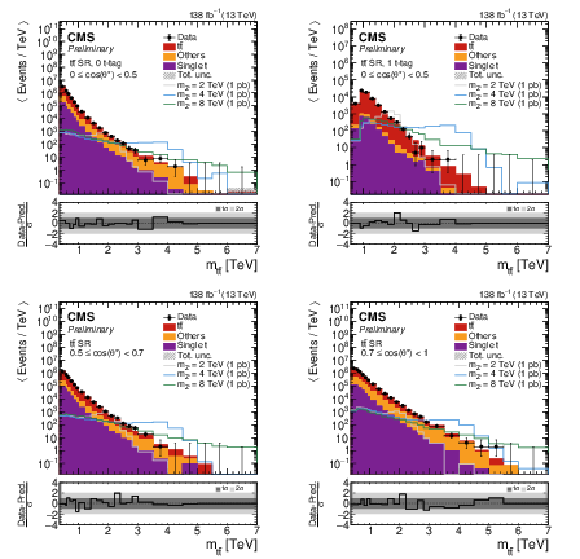
png pdf |
Figure 8:
Postfit distributions in $ m_{{\mathrm{t}\overline{\mathrm{t}}} } $ for data and simulation in the last three bins of $ \cos(\theta^*) $ in the $ \mathrm{t} \overline{\mathrm{t}} $ SR, shown for the resolved (0 t-tag, left) and boosted (1 t-tag, right) categories. The lower panels show the pull of each bin relative to the SM prediction, defined as (Data-Pred.)/$ \sigma $, where $ \sigma $ denotes the total uncertainty. The dark (light) gray band represents a pull of one (two) standard deviations from the predicted value. |
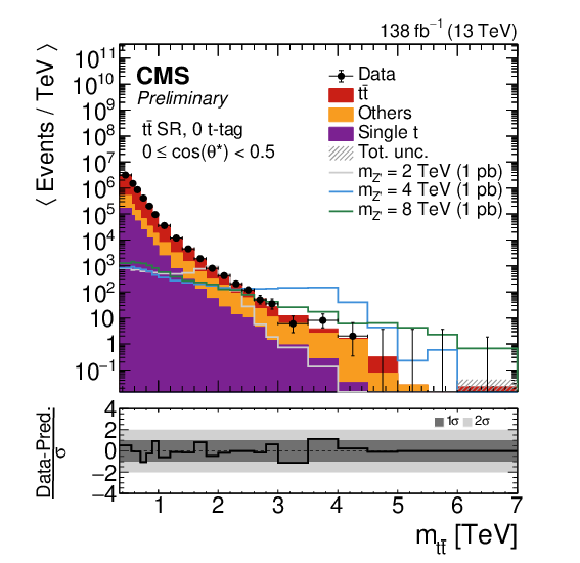
png pdf |
Figure 8-a:
Postfit distributions in $ m_{{\mathrm{t}\overline{\mathrm{t}}} } $ for data and simulation in the last three bins of $ \cos(\theta^*) $ in the $ \mathrm{t} \overline{\mathrm{t}} $ SR, shown for the resolved (0 t-tag, left) and boosted (1 t-tag, right) categories. The lower panels show the pull of each bin relative to the SM prediction, defined as (Data-Pred.)/$ \sigma $, where $ \sigma $ denotes the total uncertainty. The dark (light) gray band represents a pull of one (two) standard deviations from the predicted value. |
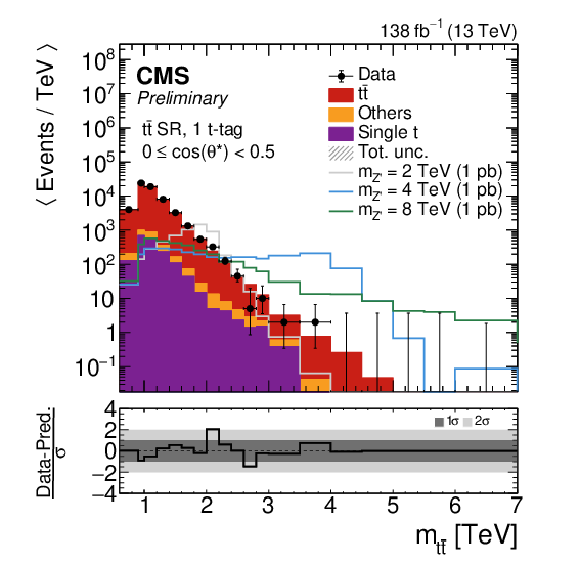
png pdf |
Figure 8-b:
Postfit distributions in $ m_{{\mathrm{t}\overline{\mathrm{t}}} } $ for data and simulation in the last three bins of $ \cos(\theta^*) $ in the $ \mathrm{t} \overline{\mathrm{t}} $ SR, shown for the resolved (0 t-tag, left) and boosted (1 t-tag, right) categories. The lower panels show the pull of each bin relative to the SM prediction, defined as (Data-Pred.)/$ \sigma $, where $ \sigma $ denotes the total uncertainty. The dark (light) gray band represents a pull of one (two) standard deviations from the predicted value. |
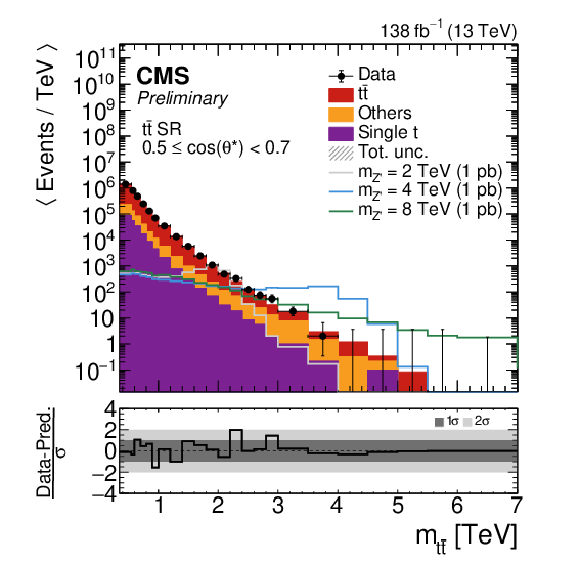
png pdf |
Figure 8-c:
Postfit distributions in $ m_{{\mathrm{t}\overline{\mathrm{t}}} } $ for data and simulation in the last three bins of $ \cos(\theta^*) $ in the $ \mathrm{t} \overline{\mathrm{t}} $ SR, shown for the resolved (0 t-tag, left) and boosted (1 t-tag, right) categories. The lower panels show the pull of each bin relative to the SM prediction, defined as (Data-Pred.)/$ \sigma $, where $ \sigma $ denotes the total uncertainty. The dark (light) gray band represents a pull of one (two) standard deviations from the predicted value. |
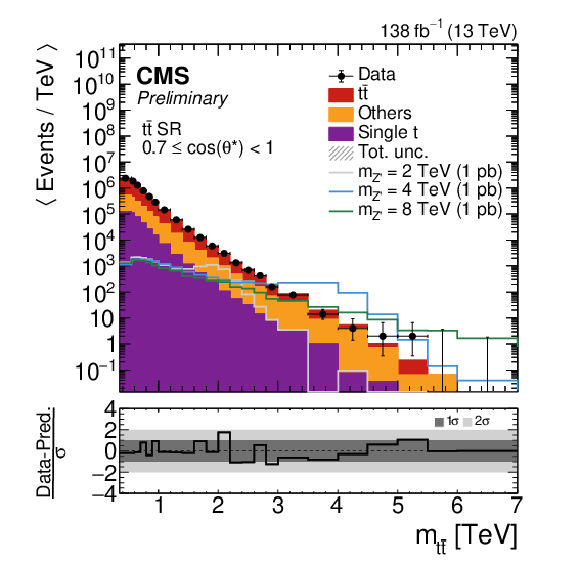
png pdf |
Figure 8-d:
Postfit distributions in $ m_{{\mathrm{t}\overline{\mathrm{t}}} } $ for data and simulation in the last three bins of $ \cos(\theta^*) $ in the $ \mathrm{t} \overline{\mathrm{t}} $ SR, shown for the resolved (0 t-tag, left) and boosted (1 t-tag, right) categories. The lower panels show the pull of each bin relative to the SM prediction, defined as (Data-Pred.)/$ \sigma $, where $ \sigma $ denotes the total uncertainty. The dark (light) gray band represents a pull of one (two) standard deviations from the predicted value. |
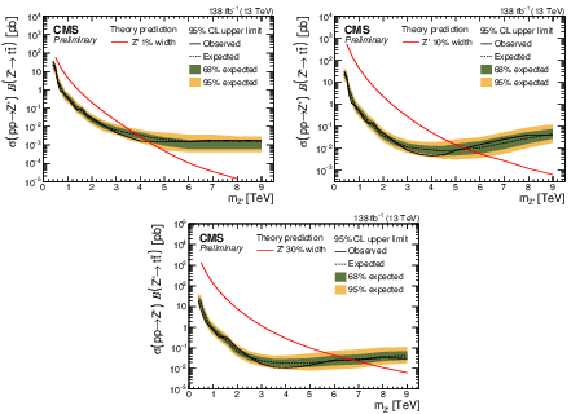
png pdf |
Figure 9:
Expected and observed upper limits at 95% CL on the product of the production cross section and the branching fraction as functions of the resonance mass. The limits are shown for Z' bosons with 1% (upper left), 10% (upper right) and 30% (lower) relative widths. The limits are compared with the respective theory predictions shown by red curves. |

png pdf |
Figure 9-a:
Expected and observed upper limits at 95% CL on the product of the production cross section and the branching fraction as functions of the resonance mass. The limits are shown for Z' bosons with 1% (upper left), 10% (upper right) and 30% (lower) relative widths. The limits are compared with the respective theory predictions shown by red curves. |
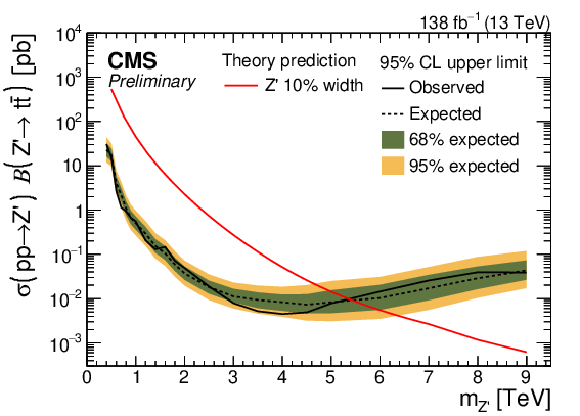
png pdf |
Figure 9-b:
Expected and observed upper limits at 95% CL on the product of the production cross section and the branching fraction as functions of the resonance mass. The limits are shown for Z' bosons with 1% (upper left), 10% (upper right) and 30% (lower) relative widths. The limits are compared with the respective theory predictions shown by red curves. |
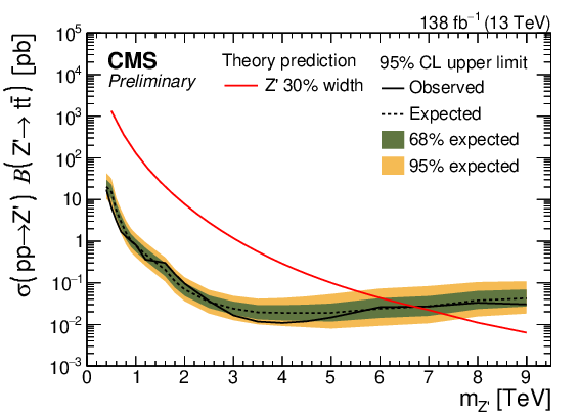
png pdf |
Figure 9-c:
Expected and observed upper limits at 95% CL on the product of the production cross section and the branching fraction as functions of the resonance mass. The limits are shown for Z' bosons with 1% (upper left), 10% (upper right) and 30% (lower) relative widths. The limits are compared with the respective theory predictions shown by red curves. |

png pdf |
Figure 10:
Expected and observed upper limits at 95% CL on the product of the production cross section and the branching fraction as functions of the resonance mass. The limits are shown for the Kaluza-Klein gluon (left) and dark matter (right) scenarios. The limits are compared with the respective theory predictions shown by red curves. |
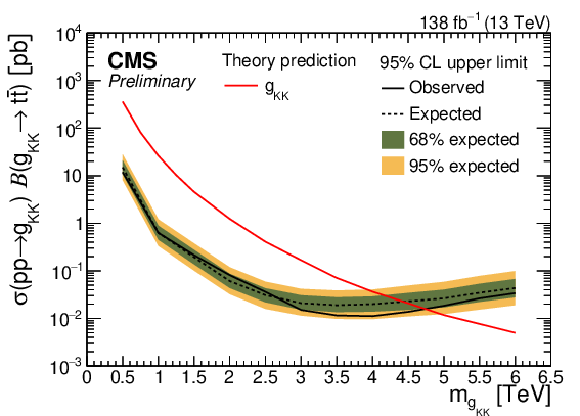
png pdf |
Figure 10-a:
Expected and observed upper limits at 95% CL on the product of the production cross section and the branching fraction as functions of the resonance mass. The limits are shown for the Kaluza-Klein gluon (left) and dark matter (right) scenarios. The limits are compared with the respective theory predictions shown by red curves. |

png pdf |
Figure 10-b:
Expected and observed upper limits at 95% CL on the product of the production cross section and the branching fraction as functions of the resonance mass. The limits are shown for the Kaluza-Klein gluon (left) and dark matter (right) scenarios. The limits are compared with the respective theory predictions shown by red curves. |
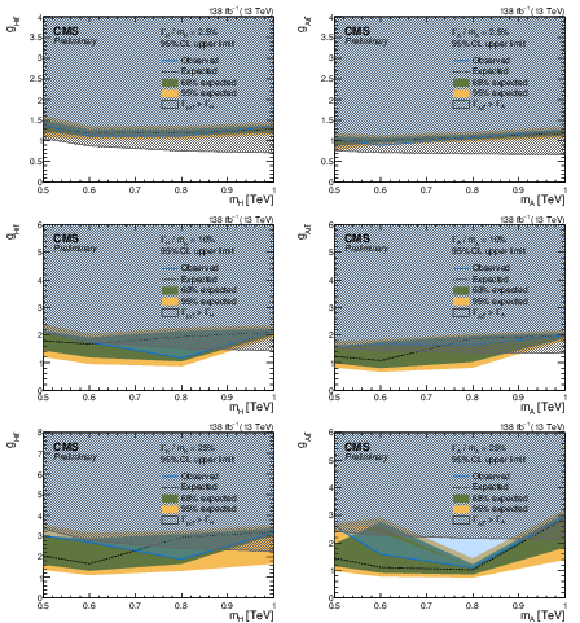
png pdf |
Figure 11:
Expected and observed upper limits at 95% CL on the coupling strength modifier for scalar (H, left) and pseudoscalar (A, right) heavy Higgs bosons with relative widths of 2.5% (upper), 10% (centre) and 25% (lower), respectively. The solid blue shaded area denotes the parameter space excluded by this search. The non-continuous shape of the excluded region, observed for the 25% width pseudoscalar signals with masses below 0.8 TeV, arises from the behavior of the $ \text{CL}_\text{s} $ scan and reflects fluctuations in the limit calculation. The gray hatched area indicates the unphysical parameter space where the partial width $ \Gamma_{\Phi{\mathrm{t}\overline{\mathrm{t}}} } $ exceeds the total width $ \Gamma_{\Phi} $. |
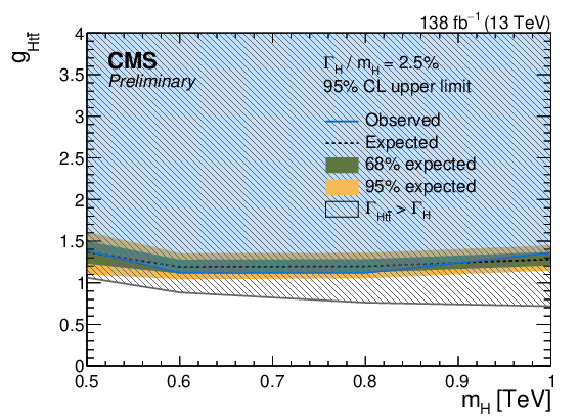
png pdf |
Figure 11-a:
Expected and observed upper limits at 95% CL on the coupling strength modifier for scalar (H, left) and pseudoscalar (A, right) heavy Higgs bosons with relative widths of 2.5% (upper), 10% (centre) and 25% (lower), respectively. The solid blue shaded area denotes the parameter space excluded by this search. The non-continuous shape of the excluded region, observed for the 25% width pseudoscalar signals with masses below 0.8 TeV, arises from the behavior of the $ \text{CL}_\text{s} $ scan and reflects fluctuations in the limit calculation. The gray hatched area indicates the unphysical parameter space where the partial width $ \Gamma_{\Phi{\mathrm{t}\overline{\mathrm{t}}} } $ exceeds the total width $ \Gamma_{\Phi} $. |
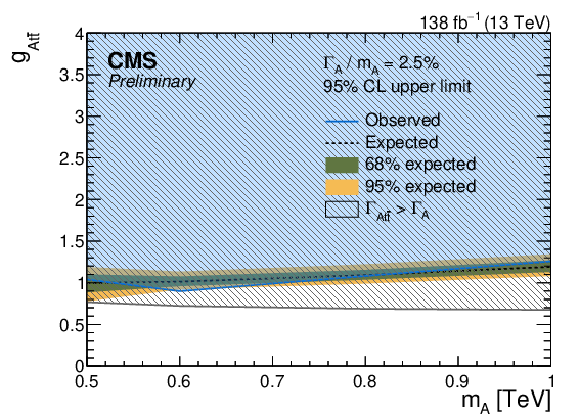
png pdf |
Figure 11-b:
Expected and observed upper limits at 95% CL on the coupling strength modifier for scalar (H, left) and pseudoscalar (A, right) heavy Higgs bosons with relative widths of 2.5% (upper), 10% (centre) and 25% (lower), respectively. The solid blue shaded area denotes the parameter space excluded by this search. The non-continuous shape of the excluded region, observed for the 25% width pseudoscalar signals with masses below 0.8 TeV, arises from the behavior of the $ \text{CL}_\text{s} $ scan and reflects fluctuations in the limit calculation. The gray hatched area indicates the unphysical parameter space where the partial width $ \Gamma_{\Phi{\mathrm{t}\overline{\mathrm{t}}} } $ exceeds the total width $ \Gamma_{\Phi} $. |
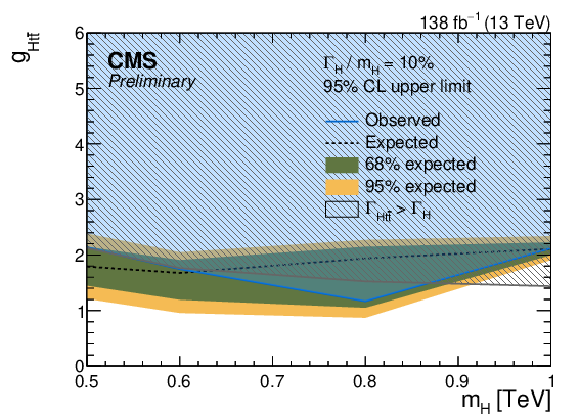
png pdf |
Figure 11-c:
Expected and observed upper limits at 95% CL on the coupling strength modifier for scalar (H, left) and pseudoscalar (A, right) heavy Higgs bosons with relative widths of 2.5% (upper), 10% (centre) and 25% (lower), respectively. The solid blue shaded area denotes the parameter space excluded by this search. The non-continuous shape of the excluded region, observed for the 25% width pseudoscalar signals with masses below 0.8 TeV, arises from the behavior of the $ \text{CL}_\text{s} $ scan and reflects fluctuations in the limit calculation. The gray hatched area indicates the unphysical parameter space where the partial width $ \Gamma_{\Phi{\mathrm{t}\overline{\mathrm{t}}} } $ exceeds the total width $ \Gamma_{\Phi} $. |
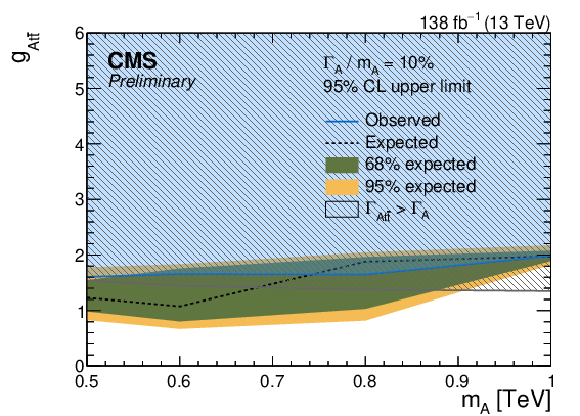
png pdf |
Figure 11-d:
Expected and observed upper limits at 95% CL on the coupling strength modifier for scalar (H, left) and pseudoscalar (A, right) heavy Higgs bosons with relative widths of 2.5% (upper), 10% (centre) and 25% (lower), respectively. The solid blue shaded area denotes the parameter space excluded by this search. The non-continuous shape of the excluded region, observed for the 25% width pseudoscalar signals with masses below 0.8 TeV, arises from the behavior of the $ \text{CL}_\text{s} $ scan and reflects fluctuations in the limit calculation. The gray hatched area indicates the unphysical parameter space where the partial width $ \Gamma_{\Phi{\mathrm{t}\overline{\mathrm{t}}} } $ exceeds the total width $ \Gamma_{\Phi} $. |

png pdf |
Figure 11-e:
Expected and observed upper limits at 95% CL on the coupling strength modifier for scalar (H, left) and pseudoscalar (A, right) heavy Higgs bosons with relative widths of 2.5% (upper), 10% (centre) and 25% (lower), respectively. The solid blue shaded area denotes the parameter space excluded by this search. The non-continuous shape of the excluded region, observed for the 25% width pseudoscalar signals with masses below 0.8 TeV, arises from the behavior of the $ \text{CL}_\text{s} $ scan and reflects fluctuations in the limit calculation. The gray hatched area indicates the unphysical parameter space where the partial width $ \Gamma_{\Phi{\mathrm{t}\overline{\mathrm{t}}} } $ exceeds the total width $ \Gamma_{\Phi} $. |
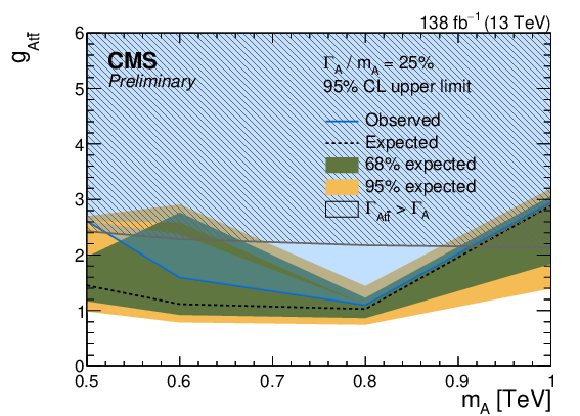
png pdf |
Figure 11-f:
Expected and observed upper limits at 95% CL on the coupling strength modifier for scalar (H, left) and pseudoscalar (A, right) heavy Higgs bosons with relative widths of 2.5% (upper), 10% (centre) and 25% (lower), respectively. The solid blue shaded area denotes the parameter space excluded by this search. The non-continuous shape of the excluded region, observed for the 25% width pseudoscalar signals with masses below 0.8 TeV, arises from the behavior of the $ \text{CL}_\text{s} $ scan and reflects fluctuations in the limit calculation. The gray hatched area indicates the unphysical parameter space where the partial width $ \Gamma_{\Phi{\mathrm{t}\overline{\mathrm{t}}} } $ exceeds the total width $ \Gamma_{\Phi} $. |
| Tables | |

png pdf |
Table 1:
Sources of systematic uncertainties considered in this analysis affecting the $ m_{{\mathrm{t}\overline{\mathrm{t}}} } $ distributions. |
| Summary |
| A search for new particles decaying to $ \mathrm{t} \overline{\mathrm{t}} $ in the lepton+jets channel has been presented. The analysis uses 138 fb$ ^{-1} $ of data collected during 2016-2018 by the CMS experiment at a centre-of-mass energy of 13 TeV. The analysis performs a model-independent search and is sensitive both to the resolved and the boosted regimes. Upper limits at 95% confidence level are placed for different benchmark models. Heavy Z' bosons in the leptophobic topcolor model with relative widths of 1%, 10%, and 30% are excluded for mass ranges of 0.4-4.3, 0.4-5.3, and 0.4-6.7 TeV, respectively. Additionally, Kaluza-Klein gluon in the Randall-Sundrum model and dark matter mediators are excluded for masses between 0.5-4.7 TeV and 1-3.2 TeV, respectively. Limits on the coupling strength modifier are set for scalar and pseudoscalar heavy Higgs bosons in the 2HDM for 2.5%, 10%, and 25% relative widths in the mass range 0.5-1 TeV. |
| References | ||||
| 1 | J. L. Rosner | Prominent decay modes of a leptophobic $ {Z}^\prime $ | PLB 387 (1996) 113 | hep-ph/9607207 |
| 2 | K. R. Lynch, S. Mrenna, M. Narain, and E. H. Simmons | Finding $ {Z}^\prime $ bosons coupled preferentially to the third family at CERN LEP and the Fermilab Tevatron | PRD 63 (2001) 035006 | hep-ph/0007286 |
| 3 | M. Carena, A. Daleo, B. A. Dobrescu, and T. M. P. Tait | Z$ ^\prime $ gauge bosons at the Fermilab Tevatron | PRD 70 (2004) 093009 | hep-ph/0408098 |
| 4 | C. T. Hill | Topcolor: top quark condensation in a gauge extension of the standard model | PLB 266 (1991) 419 | |
| 5 | R. M. Harris and S. Jain | Cross sections for leptophobic topcolor $ {Z}^\prime $ decaying to top-antitop | EPJC 72 (2012) 2072 | hep-ph/1112.4928 |
| 6 | C. T. Hill and S. J. Parke | Top quark production: Sensitivity to new physics | PRD 49 (1994) 4454 | hep-ph/9312324 |
| 7 | C. T. Hill | Topcolor assisted technicolor | PLB 345 (1995) 483 | hep-ph/9411426 |
| 8 | P. H. Frampton and S. L. Glashow | Chiral color: An alternative to the standard model | PLB 190 (1987) 157 | |
| 9 | D. Choudhury, R. M. Godbole, R. K. Singh, and K. Wagh | Top production at the Tevatron/LHC and nonstandard, strongly interacting spin one particles | PLB 657 (2007) 69 | 0810.3635 |
| 10 | D. Dicus, A. Stange, and S. Willenbrock | Higgs decay to top quarks at hadron colliders | PLB 333 (1994) 126 | hep-ph/9404359 |
| 11 | K. Agashe et al. | CERN LHC signals from warped extra dimensions | PRD 77 (2008) 015003 | hep-ph/0612015 |
| 12 | H. Davoudiasl, J. L. Hewett, and T. G. Rizzo | Phenomenology of the Randall-Sundrum Gauge Hierarchy Model | PRL 84 (2000) 2080 | hep-ph/9909255 |
| 13 | L. Randall and R. Sundrum | A Large mass hierarchy from a small extra dimension | PRL 83 (1999) 3370 | hep-ph/9905221 |
| 14 | ATLAS Collaboration | Search for $ t\overline{t} $ resonances in fully hadronic final states in $ pp $ collisions at $ \sqrt{s} = $ 13 TeV with the ATLAS detector | JHEP 10 (2020) 061 | 2005.05138 |
| 15 | CMS Collaboration | Search for resonant $ {\mathrm{t}\overline{\mathrm{t}}} $ production in proton-proton collisions at $ \sqrt{s} = $ 13 TeV | JHEP 19 (2019) 031 | 1810.05905 |
| 16 | CMS Collaboration | Search for heavy pseudoscalar and scalar bosons decaying to top quark pairs in proton-proton collisions at $ \sqrt{s}= $ 13 TeV | CMS Physics Analysis Summary, 2025 CMS-PAS-HIG-22-013 |
CMS-PAS-HIG-22-013 |
| 17 | CMS Collaboration | Observation of a pseudoscalar excess at the top quark pair production threshold | Submitted to Reports on Progress in Physics | CMS-TOP-24-007 2503.22382 |
| 18 | V. D. Barger, W. Keung, and E. Ma | A Gauge Model With Light $ W $ and $ Z $ Bosons | PRD 22 (1980) 727 | |
| 19 | B. Bellazzini, C. Csáki, and J. Serra | Composite Higgses | EPJC 74 (2014) 2766 | 1401.2457 |
| 20 | R. Contino, D. Marzocca, D. Pappadopulo, and R. Rattazzi | On the effect of resonances in composite Higgs phenomenology | JHEP 10 (2011) 081 | 1109.1570 |
| 21 | A. Albert et al. | Recommendations of the LHC Dark Matter Working Group: Comparing LHC searches for dark matter mediators in visible and invisible decay channels and calculations of the thermal relic density | Phys. Dark Univ. 26 (2019) 100377 | 1703.05703 |
| 22 | R. Bonciani et al. | Electroweak top-quark pair production at the LHC with $ Z' $ bosons to NLO QCD in POWHEG | JHEP 02 (2016) 141 | 1511.08185 |
| 23 | T. D. Lee | A Theory of Spontaneous T Violation | PRD 8 (1973) 1226 | |
| 24 | G. C. Branco et al. | Theory and phenomenology of two-Higgs-doublet models | Phys. Rept. 516 (2012) 1 | 1106.0034 |
| 25 | H. E. Haber and O. Stral | New LHC benchmarks for the $ \mathcal{CP} $ -conserving two-Higgs-doublet model | EPJC 75 (2015) 491 | 1507.04281 |
| 26 | F. Kling, J. M. No, and S. Su | Anatomy of exotic Higgs decays in 2HDM | JHEP 09 (2016) 093 | 1604.01406 |
| 27 | CMS Collaboration | The CMS experiment at the CERN LHC | JINST 3 (2008) S08004 | |
| 28 | CMS Collaboration | Electron and photon reconstruction and identification with the CMS experiment at the CERN LHC | JINST 16 (2021) P05014 | CMS-EGM-17-001 2012.06888 |
| 29 | CMS Collaboration | Performance of the CMS muon detector and muon reconstruction with proton--proton collisions at $ \sqrt{s}= $ 13 TeV | JINST 13 (2018) P06015 | CMS-MUO-16-001 1804.04528 |
| 30 | CMS Collaboration | Description and performance of track and primary-vertex reconstruction with the CMS tracker | JINST 9 (2014) P10009 | CMS-TRK-11-001 1405.6569 |
| 31 | CMS Collaboration | Particle-flow reconstruction and global event description with the CMS detector | JINST 12 (2017) P10003 | CMS-PRF-14-001 1706.04965 |
| 32 | CMS Collaboration | Jet energy scale and resolution in the CMS experiment in pp collisions at 8 TeV | JINST 12 (2017) P02014 | CMS-JME-13-004 1607.03663 |
| 33 | CMS Collaboration | Performance of reconstruction and identification of $ \tau $ leptons decaying to hadrons and $ \nu_\tau $ in pp collisions at $ \sqrt{s}= $ 13 TeV | JINST 13 (2018) P10005 | CMS-TAU-16-003 1809.02816 |
| 34 | CMS Collaboration | Performance of missing transverse momentum reconstruction in proton-proton collisions at $ \sqrt{s} = $ 13 TeV using the CMS detector | JINST 14 (2019) P07004 | CMS-JME-17-001 1903.06078 |
| 35 | CMS Collaboration | Performance of the CMS Level-1 trigger in proton-proton collisions at $ \sqrt{s} = $ 13 TeV | JINST 15 (2020) P10017 | CMS-TRG-17-001 2006.10165 |
| 36 | CMS Collaboration | The CMS trigger system | JINST 12 (2017) P01020 | CMS-TRG-12-001 1609.02366 |
| 37 | CMS Collaboration | Technical proposal for the Phase-II upgrade of the Compact Muon Solenoid | CMS Technical Proposal CERN-LHCC-2015-010, CMS-TDR-15-02, 2015 CDS |
|
| 38 | M. Cacciari, G. P. Salam, and G. Soyez | FastJet user manual | EPJC 72 (2012) 1896 | 1111.6097 |
| 39 | M. Cacciari, G. P. Salam, and G. Soyez | The anti-$ k_{\mathrm{T}} $ jet clustering algorithm | JHEP 04 (2008) 063 | 0802.1189 |
| 40 | CMS Collaboration | Pileup mitigation at CMS in 13 TeV data | JINST 15 (2020) P09018 | CMS-JME-18-001 2003.00503 |
| 41 | D. Bertolini, P. Harris, M. Low, and N. Tran | Pileup per particle identification | JHEP 10 (2014) 059 | 1407.6013 |
| 42 | A. J. Larkoski, S. Marzani, G. Soyez, and J. Thaler | Soft drop | JHEP 05 (2014) 146 | 1402.2657 |
| 43 | M. Dasgupta, A. Fregoso, S. Marzani, and G. P. Salam | Towards an understanding of jet substructure | JHEP 09 (2013) 029 | 1307.0007 |
| 44 | Y. L. Dokshitzer, G. D. Leder, S. Moretti, and B. R. Webber | Better jet clustering algorithms | JHEP 08 (1997) 001 | hep-ph/9707323 |
| 45 | M. Wobisch and T. Wengler | Hadronization corrections to jet cross-sections in deep inelastic scattering | in Proceedings of the Workshop on Monte Carlo Generators for HERA Physics, Hamburg, Germany, 1998 link |
hep-ph/9907280 |
| 46 | CMS Collaboration | Identification of heavy-flavour jets with the CMS detector in pp collisions at 13 TeV | JINST 13 (2018) P05011 | CMS-BTV-16-002 1712.07158 |
| 47 | E. Bols et al. | Jet Flavour Classification Using DeepJet | JINST 15 (2020) P12012 | 2008.10519 |
| 48 | CMS Collaboration | Identification of heavy, energetic, hadronically decaying particles using machine-learning techniques | JINST 15 (2020) P06005 | CMS-JME-18-002 2004.08262 |
| 49 | P. Nason | A new method for combining NLO QCD with shower Monte Carlo algorithms | JHEP 11 (2004) 040 | hep-ph/0409146 |
| 50 | S. Frixione, P. Nason, and C. Oleari | Matching NLO QCD computations with parton shower simulations: The POWHEG method | JHEP 11 (2007) 070 | 0709.2092 |
| 51 | S. Frixione, P. Nason, and G. Ridolfi | A positive-weight next-to-leading-order Monte Carlo for heavy flavour hadroproduction | JHEP 09 (2007) 126 | 0707.3088 |
| 52 | S. Alioli, P. Nason, C. Oleari, and E. Re | A general framework for implementing NLO calculations in shower Monte Carlo programs: The POWHEG BOX | JHEP 06 (2010) 043 | 1002.2581 |
| 53 | E. Re | Single-top $ {\mathrm{W}}{\mathrm{t}} $-channel production matched with parton showers using the POWHEG method | EPJC 71 (2011) 1547 | 1009.2450 |
| 54 | M. Czakon and A. Mitov | Top++: A program for the calculation of the top-pair cross-section at hadron colliders | Comput. Phys. Commun. 185 (2014) 2930 | 1112.5675 |
| 55 | Alwall, J. and Hoeche, S. and Krauss, F. and Lavesson, N. and Loennblad, L. and Maltoni, F. and Mangano, M. L. and Moretti, M. and Papadopoulos, C. G. and Piccinini, F. and Schumann, S. and Treccani, M. and Winter, J. and Worek, M. | Comparative study of various algorithms for the merging of parton showers and matrix elements in hadronic collisions | EPJC 53 (2008) 473 | 0706.2569 |
| 56 | J. Alwall et al. | The automated computation of tree-level and next-to-leading order differential cross sections, and their matching to parton shower simulations | JHEP 07 (2014) 079 | 1405.0301 |
| 57 | T. Sjöstrand et al. | An introduction to PYTHIA 8.2 | Comput. Phys. Commun. 191 (2015) 159 | 1410.3012 |
| 58 | J. M. Lindert et al. | Precise predictions for v+jets dark matter backgrounds | EPJC 77 (2017) 829 | 1705.04664 |
| 59 | J. Gao et al. | Next-to-leading order QCD corrections to the heavy resonance production and decay into top quark pair at the LHC | PRD 82 (2010) 014020 | 1004.0876 |
| 60 | B. Hespel, F. Maltoni, and E. Vryonidou | Signal background interference effects in heavy scalar production and decay to a top-anti-top pair | JHEP 10 (2016) 016 | 1606.04149 |
| 61 | CMS Collaboration | Extraction and validation of a new set of CMS PYTHIA8 tunes from underlying-event measurements | EPJC 80 (2020) 4 | CMS-GEN-17-001 1903.12179 |
| 62 | NNPDF Collaboration | Parton distributions from high-precision collider data | EPJC 77 (2017) 663 | 1706.00428 |
| 63 | GEANT4 Collaboration | GEANT 4 --- A simulation toolkit | NIM A 506 (2003) 250 | |
| 64 | CMS Collaboration | Measurement of the inelastic proton-proton cross section at $ \sqrt{s}= $ 13 TeV | JHEP 07 (2018) 161 | CMS-FSQ-15-005 1802.02613 |
| 65 | CMS Collaboration | Measurement of the tt charge asymmetry in events with highly Lorentz-boosted top quarks in pp collisions at s=13 TeV | PLB 846 (2023) 137703 | CMS-TOP-21-014 2208.02751 |
| 66 | M. Carena and Z. Liu | Challenges and opportunities for heavy scalar searches in the $ \mathrm{t} \overline{\mathrm{t}} $ channel at the LHC | JHEP 11 (2016) 159 | 1608.07282 |
| 67 | A. Djouadi, J. Ellis, A. Popov, and J. Quevillon | Interference effects in $ \mathrm{t} \overline{\mathrm{t}} $ production at the LHC as a window on new physics | JHEP 03 (2019) 119 | 1901.03417 |
| 68 | F. Chollet et al. | Keras | link | |
| 69 | J. Thaler and K. Van Tilburg | Identifying boosted objects with N-subjettiness | JHEP 03 (2011) 015 | 1011.2268 |
| 70 | J. Thaler and K. Van Tilburg | Maximizing Boosted Top Identification by Minimizing N-subjettiness | JHEP 02 (2012) 093 | 1108.2701 |
| 71 | CMS Collaboration | Search for heavy Higgs bosons decaying to a top quark pair in proton-proton collisions at $ \sqrt{s} = $ 13 TeV | JHEP 04 (2020) 171 | CMS-HIG-17-027 1908.01115 |
| 72 | J. Butterworth et al. | PDF4LHC recommendations for LHC Run II | JPG 43 (2016) 023001 | 1510.03865 |
| 73 | CMS Collaboration | Precision luminosity measurement in proton-proton collisions at $ \sqrt{s}= $ 13 TeV in 2015 and 2016 at CMS | EPJC 81 (2021) 800 | CMS-LUM-17-003 2104.01927 |
| 74 | CMS Collaboration | CMS luminosity measurement for the 2017 data-taking period at $ \sqrt{s}= $ 13 TeV | CMS Physics Analysis Summary, 2018 CMS-PAS-LUM-17-004 |
CMS-PAS-LUM-17-004 |
| 75 | CMS Collaboration | CMS luminosity measurement for the 2018 data-taking period at $ \sqrt{s}= $ 13 TeV | CMS Physics Analysis Summary, 2019 CMS-PAS-LUM-18-002 |
CMS-PAS-LUM-18-002 |
| 76 | ATLAS and CMS Collaborations, and LHC Higgs Combination Group | Procedure for the LHC Higgs boson search combination in Summer 2011 | CMS Note CMS-NOTE-2011-005, ATL-PHYS-PUB-2011-11, 2011 | |
| 77 | T. Junk | Confidence level computation for combining searches with small statistics | NIM A 434 (1999) 435 | hep-ex/9902006 |
| 78 | A. L. Read | Presentation of search results: The CL$ _{\text{s}} $ technique | JPG 28 (2002) 2693 | |
| 79 | G. Cowan, K. Cranmer, E. Gross, and O. Vitells | Asymptotic formulae for likelihood-based tests of new physics | EPJC 71 (2011) 1554 | 1007.1727 |
| 80 | CMS Collaboration | The CMS statistical analysis and combination tool: Combine | Accepted by Comput. Softw. Big Sci, 2024 | CMS-CAT-23-001 2404.06614 |
| 81 | W. Verkerke and D. P. Kirkby | The RooFit toolkit for data modeling | in Proc. Int. Conf. on Computing in High Energy and Nuclear Physics (CHEP03), L. Lyons and M. Karagoz, eds., 2003 | physics/0306116 |
| 82 | L. Moneta et al. | The RooStats project | in Proc. 13th Int. Workshop on Advanced Computing and Analysis Techniques in Physics Research, T. Speer et al., eds., 2010 link |
1009.1003 |

|
Compact Muon Solenoid LHC, CERN |

|

|

|

|

|

|